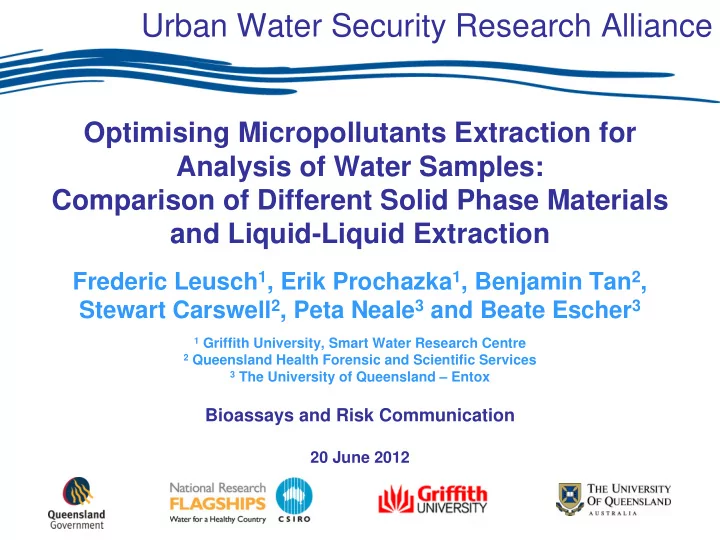

Urban Water Security Research Alliance Optimising Micropollutants Extraction for Analysis of Water Samples: Comparison of Different Solid Phase Materials and Liquid-Liquid Extraction Frederic Leusch 1 , Erik Prochazka 1 , Benjamin Tan 2 , Stewart Carswell 2 , Peta Neale 3 and Beate Escher 3 1 Griffith University, Smart Water Research Centre 2 Queensland Health Forensic and Scientific Services 3 The University of Queensland – Entox Bioassays and Risk Communication 20 June 2012
CHEMICALS IN THE ENVIRONMENT • 63+ million chemicals with >100,000 in commercial use Class Agric. Indust. Urban Natural X Pesticides X X Pharmaceuticals and personal care products (PPCPs) X X Hormones X X Industrial compounds X X X Metals and inorganics + their transformation products • There are simply too many chemicals out there to quantify them one by one …
A ROLE FOR BIOANALYTICAL TOOLS • Toxicity testing, and bioanalytical tools in particular, can overcome some of the challenges of environmental monitoring • Detect chemicals by their effect, not their structure – Non-target compounds – Transformation products – Mixture effects • “Is there a needle in the haystack?”
THE PROBLEM … • Similar to chemical analysis, bioanalytical tools require a water sample to be processed prior to analysis – Filtration followed by solid phase extraction (SPE) to concentrate organic compounds • Are there unintended consequences of sample preparation? – Are we losing important (toxic?) compounds?
EXTRACTION: A NECESSARY EVIL Solid phase extraction enrichment dilution V water volume of extract added to assay total volume of assay V extract relative enrichment factor REF = enrichment factor SPE X dilution factor assay REF = 1 “original sample” REF = 1 “original sample” enrichment dilution Macova, Toze, Hodgers, Mueller, Bartkow, Escher (2011). Bioanalytical tools for the evaluation of organic micropollutants during sewage treatment, water recycling and drinking water generation. Water Research 45: 4238-4247.
EXTRACTION: A NECESSARY EVIL Solid phase extraction enrichment dilution V water volume of extract added to assay total volume of assay V extract relative enrichment factor REF = enrichment factor SPE X dilution factor assay REF = 1 “original sample” REF = 1 “original sample” enrichment dilution Macova, Toze, Hodgers, Mueller, Bartkow, Escher (2011). Bioanalytical tools for the evaluation of organic micropollutants during sewage treatment, water recycling and drinking water generation. Water Research 45: 4238-4247.
PROJECT AIM • Can we develop an extraction method that minimizes chemical loss?
EXPERIMENTAL DESIGN: STAGE 1 179 pesticides @ 1 ug/L Mix of 263 Mix of 263 84 pharmaceuticals @ 20 ng/L compounds compounds ultrapure water 1L 1L pH 2 pH 7 pH 2 pH 7 Oasis Bond Supel Strata Bond Supel LLE LLE HLB Elut HLB X Elut CC EthA MTBE PPL GC Elute (MeOH, acetone/hexane), Evaporate Rotovap Elute (MeOH, acetone/hexane), Evaporate Rotovap Chemical analysis (LC-MS/MS, GC-MS/MS)
SPIKED COMPOUNDS pKa log Kow
RESULTS – STAGE 1 NA NA NA NA Oasis Bond Supel Strata Bond Supel LLE LLE Oasis Bond Supel Strata Bond Supel LLE LLE HLB Elut HLB X Elut CC EthA MTBE HLB Elut HLB X Elut CC EthA MTBE PPL GC PPL GC
CONCLUSIONS – STAGE 1 • LLE performed well on average, but … – High variability – Lots of solvent (60% of sample, vs 1% with SPE) – Contaminants even from high-grade solvent • SPE (HLB) was very effective – Oasis HLB and Strata X performed best, but other options performed well too • SPE (carbon) poor overall, but … – Fair recovery of a few compounds not well recovered by HLB
ULTRAPURE VS RIVER WATER • Does organic matter (present in environmental samples) interfere with extraction efficiency? ultrapure water tap water river water TOC = 0.15 mg/L TOC = 2.05 mg/L TOC = 8.31 mg/L
EXPERIMENTAL DESIGN – STAGE 2 12 EDCs @ 50 ng/L Mix of 315 Mix of 315 215 pesticides @ 0.8 ug/L compounds compounds 88 pharmaceuticals @ 30 ng/L tap water river water 1L 1L 1L 1L 1L 1L 1L 1L (filtered) pH 2 pH 7 pH 2 pH 7 Oasis HLB Supel CC Elute (MeOH, acetone/hexane), Evaporate Elute (MeOH, acetone/hexane), Evaporate Chemical analysis (LC-MS/MS, GC-MS/MS)
RESULTS – STAGE 2 NA NA
CONCLUSIONS – STAGE 2 • With combined Oasis HLB and Supelco CC – Excellent recovery of wide range of compounds in environmentally relevant matrices – Better recovery than with ultrapure water (keeper effect?) • However: – 2x more solvent in stacked mode – More complex process • Make our own cartridges?
RECOMMENDED PROTOCOL pH 2 pH 2 SPE SPE 1L HLB/CC HLB/CC Elute Elute (MeOH, acetone/hexane) (MeOH, acetone/hexane) Add keeper Add keeper (2 uL DMSO) (2 uL DMSO) 1mL Evaporate Evaporate
FUTURE WORK • Develop an empirical-based model to predict the recovery of compounds on various SPE sorbents to predict recovery of untested compounds • Important variables include – Sorbent – Kow – Ionised / unionised
ACKNOWLEDGMENT • This project was supported by the Urban Water Security Research Alliance • We thank Dr Nicole Knight, Steve Carter and Vince Alberts for laboratory support
Urban Water Security Research Alliance THANK YOU www.urbanwateralliance.org.au
Recommend
More recommend